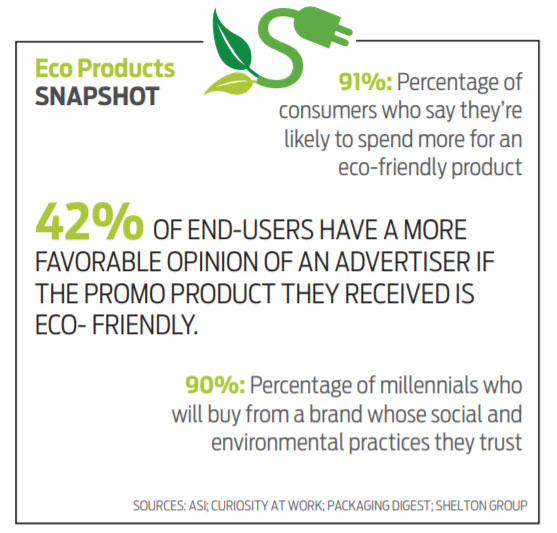May 14, 2019
How to Target the Eco-Conscious Market
Once just nice to have, eco-conscious products are now a priority for many brands.
Takeaways:
1. More companies recognize the importance of eco-consciousness.
2. Product sourcing takes legwork.
3. Honesty is the best policy to avoid brand missteps.

The Pro: Joan Bluestone Landorf; Title: Executive Vice President/Partner; Company: Axis Promotions (asi/128263), New York City
Consider Eco-Conscious for More Clients
“I’ve been working in eco products for the past 10 years. Beauty clients always want some percentage of post-consumer waste in the product packaging they buy. They seem to be more aware than clients in other industries about the importance of eco-friendliness. Eco-conscious is important to a lot of customers, but the price/value relationship still isn’t always in sync; the products tend to be more expensive than they’re used to. But now, brands realize they have a responsibility to offer eco-friendly products.”
Be Aware of Trends
“One beauty client I have is buying more and more items that are better for the environment. We’ve done stainless-steel straws and recyclable paper cups for them recently. All their shopping bags have to be at least 60% post-consumer waste. Customers are buying more RPET, which is soda bottles made into fabric, and there’s been a shift toward organic cotton and even fair-trade cotton. The demand is definitely growing. We’re going to see more eco alternatives and items that are reusable and compostable.”
33% of consumers choose to do business with brands they believe are environmentally and socially conscious. — (Unilever)
Know How to Source Properly
“Most of the products we do are for events, particularly experiential events and new store openings. It can be a gift-with-purchase or giveaway, but it has to reflect their branding and positioning. But distributors need to know what they’re actually sourcing – it’s called a transparent supply chain. Prop 65 caps the amount of phthalates that can be in a given product. Phthalates don’t decompose – they sit in landfills and release toxins into the environment. But if a client says they don’t want any phthalates at all in their products, and even if that product meets California’s Prop 65 regulations (which caps the amount of allowable phthalates), it’s still not what the client wants. Some clients will say absolutely no PVC of any kind; you have to look at alternate materials.”
Get Familiar With Product Nuances
“The most important thing is that distributors need to be knowledgeable about materials. ‘Eco-friendly’ is an overused term. It can get you in trouble with your clients. If you sell something to them you say is eco-friendly and then someone analyzes it and says it’s not, you have people on social media talking about your client’s brand. We need to check and understand. People aren’t intentionally deceiving each other; they just don’t know. Suppliers often aren’t manufacturers. Saying to a client ‘I’ll find out for you’ is an honest answer, rather than saying it’s eco-friendly when you don’t actually know.”
Statistics

Providing Honesty and Transparency
Breezie Soward owns Ecoimprint LLC (asi/185831) in Fort Worth, TX, which specializes in eco-friendly products. She and her team pride themselves on protecting their clients’ brands. “They know if something isn’t actually eco-friendly, we’ll tell them,” she says. “Just because a bag is marketed as an eco-friendly nonwoven doesn’t necessarily mean it’s made of recycled material.”

Product Hub
Find the latest in quality products, must-know trends and fresh ideas for upcoming end-buyer campaigns.